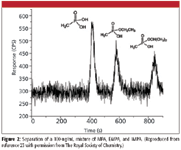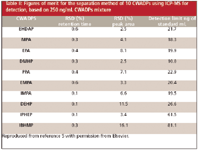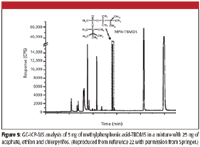Chemical Warfare Nerve Agents — Analyzing Their Degradation Products
Research regarding detection of chemical warfare agents has become vital for finding solutions that will help reduce the threat of these substances. This article looks at the use of collision cell ICP-MS for the analysis and detection of organophosphorus agents.
In a 1995 incident, members of Aum Shinrikyo released sarin (GB) at a Tokyo subway, killing 12 people and injuring many more (1). Due to this and other more recent activities, the threat of terrorists acquiring and using chemical warfare agents (CWAs) is of extreme importance. Also, current stockpiles of CWAs must be monitored to ensure their safe storage and disposal. The remediation of sites containing abandoned CWAs in the world requires analysis in support of safe removal and destruction of agents. So the need for methods able to accurately analyze those agents with lowest levels of detection possible is desirable; therefore, 31 P detection with ICP-MS is highlighted here.
The Chemical Weapons Convention (CWC), which came into effect on April 29, 1997, bans the production, acquisition, and direct or indirect transfer of chemical weapons, and also mandates the destruction of all chemical weapons held in reserve by member states (2). A United Nations report from 1969 defines chemical warfare agents as "chemical substances, whether gaseous, liquid or solid, which might be employed because of their direct toxic effects on man, animals and plants" (3).
Chemical warfare agents can be classified as lethal agents: blood agents (cyanogens chloride), blister agents (sulfur mustard gas), nerve agents (tabun, sarin), pulmonary agents (chlorine), and nonlethal agents: incapacitating agents (Agent 15) and riot-control agents (pepper spray).
Of these, nerve agents are the most notorious. These agents are a class of phosphorus-containing organic chemicals (organophosphates) that bind in blood primarily and extremely rapidly to the enzymes acetyl- and butyrylcholinesterase(4).
There are two main classes of nerve agents based upon alkylphosphonic acid esters. The members of the two classes share similar properties and both are given a common name (such as sarin), and a two-character NATO identifier (such as GB for sarin).
G-Series. The G-series is thus named because German scientists first synthesized them. All of the compounds in this class were discovered and synthesized during or soon after World War II.
V-Series. The V-series is the second family of nerve agents (the V apparently standing for "venomous"), and contains four members: VE, VG, VM, and VX. The most studied agent in this family is the VX (4). As G-type and V-type agents enter the environment, they hydrolyze rapidly into their degradation products (CWADPs), specifically into organophosphorus acid degradation products, which generally are thought to be less toxic (Figure 1) (5).

Figure 1
Although the toxicities of CWADPs are thought to be significantly lower than their parent agents, the exact health risk is relatively unknown (6). The large number of possible CWADPs leads to the incomplete knowledge regarding toxicity.
Phosphorus-containing nerve agents along with their degradation products present difficulties for ultratrace analysis due to their high polarity, extremely low (or lack) of volatility for the degradation products, and lack of a good chromophore. Previous studies have successfully utilized methods such as gas chromatography–mass spectrometry (GC–MS), ion mobility–mass spectrometry (IM–MS), and liquid chromatography–mass spectrometry (LC–MS) for the analysis of organophosphorus-containing degradation products with detection limits in the nanograms-per-milliliter range (7–10).
GC with various detection methods such as atomic emission detection (11,12), flame photometric detection (13), inductively coupled plasma–mass spectrometry (ICP-MS) (14), MS (15–18), and tandem MS (19,20) has been employed for analysis of CWADPs. The low volatility of CWADPs requires them to be derivatized for GC separation analysis, and divalent metals can cause interferences with derivatization steps (16). LC–MS and LC–MS-MS are commonly used techniques for the detection of CWADPs because of their selectivity, sensitivity, and structural identification capabilities. However, ionization involving conventional MS sources such as atmospheric pressure chemical ionization (APCI) or electrospray ionization (ESI) can pose difficulties from the constituents of various mobile phases and extraneous sample matrix components (21).
Considering the lethal doses of the degradation products, lower detection limits require a more selective analytical detection technique such as ICP-MS. Also, for the most part, ICP-MS is more tolerant of difficult matrices, and can be used with mobile phases not suitable for APCI or ESI-MS (22).
ICP-MS is an element-specific detection technique capable of qualitative and quantitative determination. It has a large dynamic range, high sensitivity, low detection levels (often at low to sub part-per-trillion levels for some analytes), and it is interfaced easily with LC. Elemental speciation analysis by ICP-MS allows for high sensitivity, low level detection, and elemental selectivity, making it an excellent choice for ultratrace elemental speciation studies (23–25).
Phosphorus (m/z = 31) analysis by ICP-MS was limited for many years due to its high first ionization potential (10.5 eV) and due to the polyatomic interferences such as 14N16O1H+ and 15N16O+ (m/z = 31). Since about the turn of the century, there have been major technological advancements with the application of collision–reaction cells to ICP-MS with various gases for collision, reaction, or energy discrimination. This enhancement allows for the analysis of elements prone to isobaric and polyatomic interferences. Though ICP-MS can detect 31 P specifically in complicated matrices, its inability to differentiate various compounds containing naturally occurring 31 P requires chromatographic separation before detection. Reversed-phase ion-pairing chromatography, coupled to ICP-MS, represents a detection method for the analysis of organophosphorus degradation products of nerve agents. Both GC and LC separation methods are highlighted.
LC with ICP-MS Detection
Project 1
This study (23) has provided details of the detection of organophosphorus degradation products of sarin (GB) and VX. In this work, the coupling of ion-pairing reversed-phase high performance liquid chromatography (HPLC) with ICP-MS, equipped with a collision–reaction cell allowed for trace analysis of three organophosphorus chemical warfare degradation products: methylphosphonic acid (MPA, degradation product of VX and sarin), ethyl methylphosphonic acid (EMPA, degradation product of VX), and isopropyl methylphosphonic acid (IMPA, degradation product of sarin). Due to the charged nature of the compounds of interest, ion-pairing chromatography was investigated as the chromatographic separation technique. The acid dissociation constants for the chemical warfare degradation products are as follows: MPA, pKa1 2.41, pKa2 7.54; EMPA, pKa 2.16; IMPA, pKa 2.24. This information was used to select the buffer system.

Figure 2
Myristyl trimethylammonium bromide (TTAB), consisting of an intermediate length alkyl chain, along with an ammonium acetate–acetic acid buffer (pH 4.85) and 2% methanol for the mobile phase, allowed separation of methylphosphonic acid, ethyl methylphosphonic acid, and isopropyl methylphosphonic acid with the selected column (150 mm × 3.2 mm, 5-μm Alltima C8, Grace Davison Discovery Sciences, Deerfield, Illinois) in less than 15 min (Figure 2). Some comparative data, available at the time of this study, are summarized in Table I and illustrate the excellent compound detection limits with 31 P selective detection.

Table I
Complex samples of the Little Miami River (Ohio) water, tap water, topsoil, and potting soil samples were analyzed. Although good results were obtained, a phosphate interference was associated with the EMPA retention time. This resulted in continuing the study, investigating four methods with ion-exchange chromatography coupled to ICP-MS (5).
Project 2
Four separation methods for the determination of CWADPs using LC–ICP-MS were developed. The best separation was able to separate 10 CWADPs (MPA, EMPA, dimethyl hydrogen phosphate [DMHP], diethyl hydrogen phosphate [DEHP], ethyl hydrogen dimethylamidophosphate sodium salt [EHDAP], isopropyl methylphosphonic acid [IMPA], isopropyl hydrogen ethylphosphonate [IPHEP], isobutyl hydrogen methylphosphonate [IBHMP], ethylphosphonic acid [EPA], and propylphosphonic acid [PPA]) in the presence of H2PO4–. It had the best tolerance for H2PO4– and is applicable to several matrices. In previous studies (26,27), authors discussed conditions under which MPA could be separated from H2PO4– using flame photometric detection (FPD) for detection and concluded that a gradient separation was needed in which 70% methanol must be used. Unfortunately, this compromises or extinguishes the plasma using standard-bore columns and standard nebulizers. By adjusting the mobile phases and PRP X-100 ion-exchange column (Hamilton Company, Reno, Nevada) dimensions, a gradient utilizing various levels of formic acid, methanol, and ammonium format was developed, resulting in the separation shown in Figure 3 with figures of merit that address reproducibility and detection limits (calculated as recommended by IUPAC, 3σ of integrated peak area of seven blanks divided by the slope of the calibration curve) displayed in Table II (5).

Table II
The chromatogram in Figure 3 illustrates the separation possibilities for nine degradation products.

Figure 3
Applications were made by analyzing tap water, bottled water, grape juice, apple juice, soda, and sport drinks. Beverages that had a high level of H2PO4– showed overlap with the EPA peak. But highly positive results show the separation of EMPA, IMPA, and MPA from sarin and VX, the most widely discussed CWAs, to be separated completely from the phosphate interference, as shown in Figure 4.

Figure 4
Analysis was attempted for a sample of infant formula, which has a high number of interferences (in addition to H2PO4– ), but only six (MPA, DMHP, EMPA, DEHP, IPHEP, and IBHMP) of the spiked standards could be identified due to the high background of the blank infant formula.
Detection limits were lower than or comparable to the majority of currently published LC methods and easily meet the required limits of detection of 1 mg/mL for the OPCW tests (5).
GC with ICP-MS Detection
GC–ICP-MS is an excellent method to detect organophosphorus nerve agent degradation products, providing that volatile derivatives are attainable (14). This work analyzed several organophosphorus nerve agent degradation products, alone or in the presence of mixtures of common organophosphorus pesticides (OPPs). OPPs are the most widely used type of chemical for insecticides, herbicides, and fungicide applications (28–32). Due to the extensive use of these OPPs as agricultural products, their presence has been detected in groundwaters, drinking waters, fruits, and vegetables (28,30,33). Because of this high environmental presence, OPPs must be considered as possible interfering species for the analysis of organophosphorus nerve agent degradation products.
The first degradation products of sarin (isopropyl methylphosphonic acid, GB acid), cyclo-sarin (cyclohexyl methylphosphonic acid, GF acid), and soman (pinacolyl methylphosphonic acid), as well as their common final hydrolysis product, MPA, were utilized throughout these experiments. Due to the nonvolatile nature of these alkyl phosphonic acid degradation products, derivatization was performed to generate the volatile tert-butyl dimethylsilyl (TBDMS) species (22).
Degraded organophosphorus pesticide standards were obtained for acephate, chlorpyrifos, dichlorvos, ethion, and parathion ethyl. Mixtures consisting of three pesticides in the presence of a single nerve agent degradation product were prepared. GC–ICP-MS allowed for the separation and detection of all four degradation products in the presence of pesticide mixtures in just over 12 min.
Elemental speciation with GC–ICP-MS requires high chromatographic resolution to ensure that no interfering species overlap the degradation product standards, leading to false positives.
Figure 5 shows the analysis of the final hydrolysis product, MPA-TBDMS, in the presence of a concentration of acephate, ethion, and chlorpyrifos that was five times higher. MPA typically is used to verify release of all organophosphorus nerve agents. As a result of the highly specific hydrolysis pathway, it also is predicted that MPA will be present at higher concentrations relative to the other alkyl phosphonic acid degradation products following release into the environment. Other separations were obtained by successfully separating IMPA-TBDMS (sarin, GB acid) in the presence of a concentration of dichlorvos, ethion, and parathion ethyl pesticides that was 10 times higher. It was possible to outline specific peak to IMPA-TBDMS among multiple phosphorus-containing peaks corresponding to various hydrolysis products of the three pesticides. Similar results were obtained for CMPA and PMPA-TBDMS (cyclosarin-GF acid and soman) derivatives in the presence of pesticide mixtures. Parent pesticide peaks are still observed at the longer retention times; however, due to the age and storage of the standards, degradation would be expected. This is the first study analyzing pesticides as interfering species for analysis of nerve agent degradation products by GC–ICP-MS.

Figure 5
Karolin K. Kroening, Douglas D. Richardson, Kevin M. Kubachka, and Joseph A. Caruso are with the Department of Chemistry, University of Cincinnati/Agilent Technologies Metallomics Center of the Americas, University of Cincinnati, Cincinnati, Ohio.
References
(1) K. Miyaki, Y. Nishiwaki, K. Maekawa, Y. Ogawa, N. Asukai, K. Yoshimura, N. Etoh, Y. Matsumoto, Y. Kikuchi, N. Kumagai, and K. Omae, J. Occup. Health 47, 299–304 (2005).
(2) OPCW, Washington D.C., April 29, 1997; United States Bureau of Arms Control and Disarmament Agency.
(3) Foreign Relations, 1969–1976, Volume E-2, Documents on Arms Control, 1969–1972.
(4) Markku Mesilaakso, Chemical Weapons Convention Chemicals Analysis, Editor Wiley. 11, 250, 276 (2005).
(5) K.M. Kubachka, D.D. Richardson, D.T. Heitkemper, and J.A. Caruso, J. Chromatogr., A, 1202, 124–131 (2008).
(6) "Review of the U.S. Army Proposal for the Off-Site Treatment and disposal of Caustic VX Hydolysate from Newport Chemical Agent Disposal Facility," Department of Health and Human Services: Centers for Disease Control and Prevention, 2005.
(7) W.E. Steiner, B.H. Clowers, L.M. Matz, W.F. Siems, and H.H. Hill, Jr., Anal. Chem. 74, 4343–4352 (2002).
(8) J.R. Smith and M.L. Shih, J. Appl. Toxicol. 21, S27–S34 (2001).
(9) R.M. Black and R.W. Read, J. Chromatogr., A 794, 233–244 (1998).
(10) A.B. Kanu, P.E. Haigh, and H.H. Hill, Anal. Chim. Acta 553(1–2), 148–159 (2005).
(11) P.A. D'Agostino, J.R. Hancock, C.L. Chenier, and C.R.J. Lepage, J. Chromatogr., A 1110, 86–94 (2006).
(12) W.R. Creasy, A.A. Rodriguez, J.R. Stuff, and R.W. Warren, J. Chromatogr., A 709, 333–344 (1995).
(13) G.A. Sega, B.A. Tomkins, and W.H. Griest, J. Chromatogr., A 790, 143–152 (1997).
(14) D.D. Richardson and J.A. Caruso, Anal. Bioanal. Chem. 388, 809–823 (2007).
(15) S.V. Vasilevskii, A.F. Kireev, I.V. Rybal'chenko, and V.N. Suvorkin, J. Anal. Chem. 57, 491–497 (2002).
(16) M. Kataoka, N. Tsunoda, H. Ohta, K. Tsuge, H. Takesako, and Y. Seto, J. Chromatogr., A 824, 211–221 (1998).
(17) H. Gu, L. Zhou, G. Cai, and Y. Zhong, Sepu 14, 41–44 (1996).
(18) G. Cai, H. Gu, L. Zhou, G. Qu, and Y. Zhong, Fenxi Huaxue 24, 886–889 (1996).
(19) M.-I. Lei, H.-I. Xi, D.-N. Xu, and Z.-S. Chen, J. Mass Spectrom. 41, 1453–1458 (2006).
(20) J. Riches, I. Morton, R.W. Read, and R.M. Black, J. Chromatogr., B: Anal. Technol. Biomed. Life Sci . 816, 251–258 (2005).
(21) P.A. D'Agostino and C.L. Chenier, "Analysis of Chemical Warfare Agents: General Overview, LC-MS Review, In-House LC-ESI-MS Methods and Open Literature Biography," Defense Research and Development Canada, 2006.
(22) D.D. Richarson and J.A. Caruso, Anal. Bioanal. Chem. 389, 679–682 (2007).
(23) D.D. Richardson, B.B.M. Sadi, and J.A. Caruso, J. Anal. At. Spectrom. 21, 396–403 (2006).
(24) J.A. Caruso, B. Klaue, B. Michalke, and D.M. Rocke, Ecotoxicol. Environ. Saf. 56, 32–44 (2003).
(25) P. Leonhard, R. Pepelnik, A. Prange, N. Yamada, and T. Yamada, J. Anal. At. Spectrom. 17, 189–196 (2002).
(26) E.W.J. Hooijschuur, C.E. Kientz, and U.A.T. Brinkman, J. Chromatogr., A 928, 187–199 (2001).
(27) C.E. Kientz, A. Verweij, G.J. de Jong, and U.A. Brinkman, J. Microcolumn Sep. 4, 477–483 (1993).
(28) A.P. Vonderheide, J. Meija, M. Montes-Bayon, and J.A. Caruso, J. Anal. At. Spectrom. 18, 1097–1102 (2003).
(29) R.G. Wuillod, M. Shah, S.S. Kannamkumarath, and J.C. Altamirano, Electrophoresis 26, 1598–1605 (2005).
(30) N. Fidalgo-Used, M. Montes-Bavon, E. Blanco-Gonzales, and A. Sanz-Medel, J. Anal. At. Spectrom. 20, 876–882 (2005).
(31) S.O. Pehkonen and Q. Zhang, Crit. Rev. Environ. Sci. Technol. 32 , 17–72 (2002).
(32) S. Lacorte, S.B. Lartiges, P. Garrigues, and D. Barcelo, Environ. Sci. Technol. 29, 431–438 (1995).
(33) D. Proefrock, P. Leonhard, S. Wilbur, and A. Prange, J. Anal. At. Spectrom. 19, 623–631 (2004).
Trending on Spectroscopy: The Top Content of 2024
December 30th 2024In 2024, we launched multiple content series, covered major conferences, presented two awards, and continued our monthly Analytically Speaking episodes. Below, you'll find a selection of the most popular content from Spectroscopy over the past year.
Best of the Week: Hyperspectral Imaging, ICP-MS Analysis of Geological Samples, Product Roundup
October 18th 2024Top articles published this week include an article about hyperspectral imaging in human skin research, a peer-reviewed article about analyzing geological samples using atomic spectroscopy techniques, and an equipment roundup piece about the latest products in the industry.
